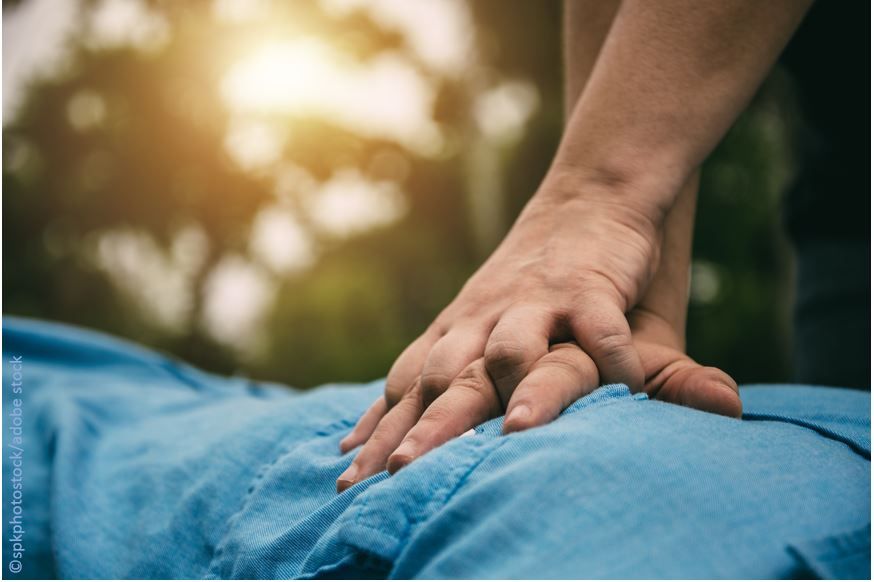- Clinical Technology
- Adult Immunization
- Hepatology
- Pediatric Immunization
- Screening
- Psychiatry
- Allergy
- Women's Health
- Cardiology
- Pediatrics
- Dermatology
- Endocrinology
- Pain Management
- Gastroenterology
- Infectious Disease
- Obesity Medicine
- Rheumatology
- Nephrology
- Neurology
- Pulmonology
Racial Minorities Less Likely to Receive CPR Regardless of Location, Community Makeup
ACC 2022. Black and Hispanic persons were 41% less likely than white individuals to receive CPR after cardiac arrest in public and 26% less likely when the event occurred in their home.
Racial disparities in acting on CPR were not explained by where the cardiac arrest occurred or by income level.

Members of racial minorities who are observed while experiencing cardiac arrest are substantially less likely to receive cardiopulmonary resuscitation (CPR) from a bystander than white individuals, according to a new study. The finding held true whether the event occurred in public or in an individual's home.
The study, being presented at the American College of Cardiology’s (ACC) 71st Annual Scientific Session, found specifically that Black and Hispanic persons were 41% less likely than white individuals to receive CPR when cardiac arrest occurred in a public place and 26% less likely when the event occurred in their home, according to an ACC statement.
“It’s critically important to understand who gets bystander CPR for a cardiac arrest and how we can improve those rates,” said study senior author Paul S. Chan, MD, professor of medicine at the University of Missouri–Kansas City School of Medicine and the Saint Luke’s Mid America Heart Institute in the press statement.
“We found that bystander CPR rates are much higher in white communities compared with Black communities. In addition, there were patient-level disparities in getting bystander CPR regardless of the type of community the person was in, even though there were, in all of these cases, bystanders who could have provided aid and assistance.”
When CPR is administered immediately, an individual is 2 to 3 times more likely to survive with full brain functioning compared to those for whom the resuscitation is delayed, states the ACC.
Chan and colleagues analyzed data from 2013-2019 on more than 110 000 cardiac arrests in the US occurring outside of a hospital and witnessed by a bystander. They found that for cardiac arrests occurring in public, 45.6% of Black and Hispanic individuals were administered CPR vs 60% of Whites (adjusted OR 0.59; 95% CI 0.56-0.63). The disparity in assistance was wider when the event occurred at home where 38.5% of the minority individuals received CPR vs 47.4% of while individuals (adjusted OR 0.75; 95% CI 0.72-0.78). The investigators report that the patterns remained after adjustments were made for the racial makeup or income level of the neighborhood where the cardiac arrest occurred.
Chan emphasized that the disparity was observed in communities regardless of whether they were majority white or majority Black and Hispanic. “A white person going into cardiac arrest in a community that was more than 50% Black and Hispanic was still more likely to get bystander CPR than a Black or Hispanic person in that community,” he said.
Chan's team did not analyze factors that may affect CPR rates but suggest that access to CPR training may play a role. They said that people are more likely to attempt CPR if they have been trained but that the cost of and access to that instruction may create barriers for some communities.
“A white person going into cardiac arrest in a community that was more than 50% Black and Hispanic was still more likely to get bystander CPR than a Black or Hispanic person in that community.”
Thinking creatively about how, where, and when to offer CPR instruction in neighborhoods where disparities appear greatest, said Chan, is important to broaden access. Reduced cost, more convenient locations, and large group trainings are a few options.
Several other variables could affect CPR administration, the researchers add, including whether a 911 dispatcher instructs bystanders on CPR delivery while waiting for an ambulance as well as language barriers that could hinder dispatcher instruction. To help reduce the real potential for implicit or explicit racial bias in bystander situations, Chan recommends that CPR training materials, including manikins, reflect racial and ethnic diversity.
Researchers said that overall rates of CPR were relatively low across all racial groups in the study. Even though bystanders were present in all cases, data showed CPR was attempted less than half the time.
"We still have a long way to go in getting the message out that people need to start CPR and not just call 911," said Chan.
Raul Angel Garcia will present the study, “Racial and Ethnic Differences in Layperson Bystander CPR in Witnessed Out-Of-Hospital Cardiac Arrests,” on Sunday, April 3, at 2:45 p.m. ET in Poster Hall, Hall C.
